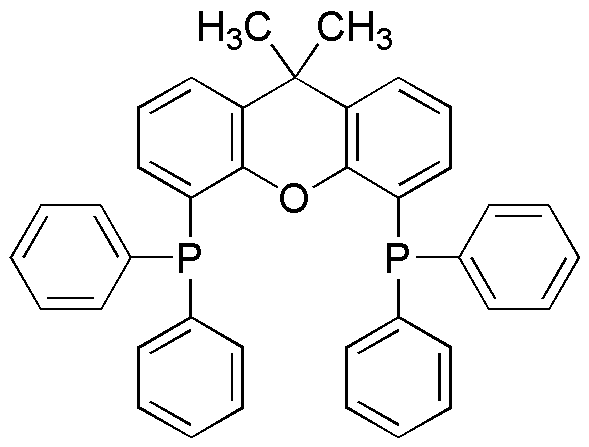Xantphos is widely utilized in research focused on:
- Catalysis: Xantphos serves as a highly effective ligand in various catalytic reactions, particularly in palladium-catalyzed cross-coupling reactions. Its ability to stabilize metal centers enhances reaction efficiency, making it invaluable in organic synthesis.
- Pharmaceutical Development: In the pharmaceutical industry, Xantphos is used to facilitate the synthesis of complex molecules. Its unique properties allow for more selective reactions, which can lead to the development of new drugs with improved efficacy.
- Material Science: This compound plays a role in the development of advanced materials, including polymers and nanomaterials. Its application in these fields can lead to innovations in electronics and coatings, offering enhanced performance and durability.
- Environmental Chemistry: Xantphos is also explored for its potential in environmental applications, such as in the degradation of pollutants. Its effectiveness in catalyzing reactions can help in the development of greener processes for waste treatment.
- Research and Development: In academic and industrial research settings, Xantphos is a key tool for chemists looking to explore new reaction pathways. Its versatility and efficiency make it a preferred choice for researchers aiming to push the boundaries of chemical synthesis.
General Information
Properties
Safety and Regulations
Applications
Xantphos is widely utilized in research focused on:
- Catalysis: Xantphos serves as a highly effective ligand in various catalytic reactions, particularly in palladium-catalyzed cross-coupling reactions. Its ability to stabilize metal centers enhances reaction efficiency, making it invaluable in organic synthesis.
- Pharmaceutical Development: In the pharmaceutical industry, Xantphos is used to facilitate the synthesis of complex molecules. Its unique properties allow for more selective reactions, which can lead to the development of new drugs with improved efficacy.
- Material Science: This compound plays a role in the development of advanced materials, including polymers and nanomaterials. Its application in these fields can lead to innovations in electronics and coatings, offering enhanced performance and durability.
- Environmental Chemistry: Xantphos is also explored for its potential in environmental applications, such as in the degradation of pollutants. Its effectiveness in catalyzing reactions can help in the development of greener processes for waste treatment.
- Research and Development: In academic and industrial research settings, Xantphos is a key tool for chemists looking to explore new reaction pathways. Its versatility and efficiency make it a preferred choice for researchers aiming to push the boundaries of chemical synthesis.
Documents
Safety Data Sheets (SDS)
The SDS provides comprehensive safety information on handling, storage, and disposal of the product.
Product Specification (PS)
The PS provides a comprehensive breakdown of the product’s properties, including chemical composition, physical state, purity, and storage requirements. It also details acceptable quality ranges and the product's intended applications.
Certificates of Analysis (COA)
Search for Certificates of Analysis (COA) by entering the products Lot Number. Lot and Batch Numbers can be found on a product’s label following the words ‘Lot’ or ‘Batch’.
*Catalog Number
*Lot Number
Certificates Of Origin (COO)
This COO confirms the country where the product was manufactured, and also details the materials and components used in it and whether it is derived from natural, synthetic, or other specific sources. This certificate may be required for customs, trade, and regulatory compliance.
*Catalog Number
*Lot Number
Safety Data Sheets (SDS)
The SDS provides comprehensive safety information on handling, storage, and disposal of the product.
DownloadProduct Specification (PS)
The PS provides a comprehensive breakdown of the product’s properties, including chemical composition, physical state, purity, and storage requirements. It also details acceptable quality ranges and the product's intended applications.
DownloadCertificates of Analysis (COA)
Search for Certificates of Analysis (COA) by entering the products Lot Number. Lot and Batch Numbers can be found on a product’s label following the words ‘Lot’ or ‘Batch’.
*Catalog Number
*Lot Number
Certificates Of Origin (COO)
This COO confirms the country where the product was manufactured, and also details the materials and components used in it and whether it is derived from natural, synthetic, or other specific sources. This certificate may be required for customs, trade, and regulatory compliance.


